Icelandic Food (traditional and non) Posted by sequoia on Aug 14, 2011 in Icelandic culture
This is my first post, so here’s a brief introduction: I’m nineteen and I’ve been living in Reykjavík for one year, taking Icelandic for Foreigners classes at the University of Iceland. I live with a Swede who works at a daycare. My other two good friends are a Finn and an Icelander, so if I comment with “I heard in Sweden they…”, this is why.
Here’s some “Icelandic” foods. Some (or even all) of these may not be uniquely Icelandic, but they’re things I’ve noticed are either said to be Icelandic or just couldn’t be found where I lived in America.
Minke whale steak. It cost around 4.000kr (kr is short for krónur or króna, crowns or crown – estimate this price as $35 US) at Café Paris in Reykjavík’s city centre, if I remember correctly. I’ve also seen that you can buy whale kabobs, but I haven’t had them.
Hrafnreyður, hrefna – minke whale
Buff – steak
Hestur, hross – horse
Pylsa – sausage, hotdog
Bjúga – smoked sausage
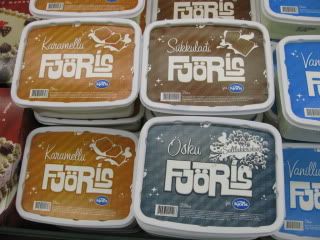
“Ash” (licorice) flavoured ice cream. It is grey ice cream instead of vanilla ice cream with chunks of licorice in it, and everyone who tried it with me agreed that it was horrible (and we all like licorice).
Aska – ash, ashes
Ís – ice cream
Súkkulaði – Chocolate
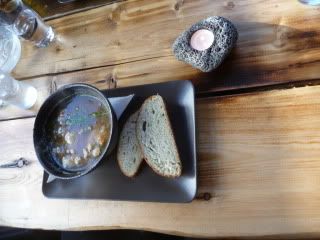
(Photo taken in the new viking restaurant that just opened in Reykjavík.)
Lamb meat soup is often said to be Icelandic, although frankly I can’t tell the difference between this and what my dad used to make. They also sell packets of seasoning for when you’re making the soup at home.
Kind – sheep
Dilkur – lamb
Lambakjöt, dilkakjöt – lamb meat
Hangikjöt – smoked meat, usually lamb
Súpa – soup
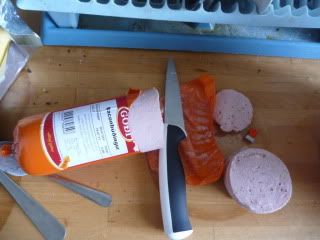
Pepperoni sausage. It tasted more like ham than pepperoni.
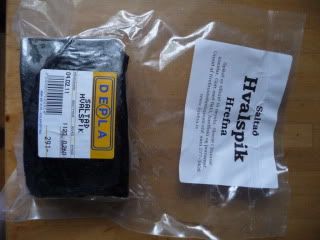
Whale fat. If you eat it without cooking it, it tastes like seawater. If you cut off chunks and fry it, it doesn’t taste like seawater anymore and is more like a snack you might buy instead of dried fish. Very cheap, maybe around 300kr. It’s very, very hard to cut even after sharpening my knives.
Hvalur – whale
Spik – fat
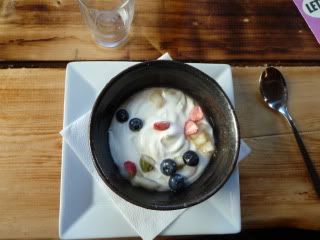
Skyr is distinctly Icelandic. This is “dessert skyr”, which was mixed with whipped cream and probably sugar. Plain skyr is very sour, so most people mix something into it (I’ve seen jam, sugar, and berries used) to make it taste better. I forgot how much this cost, maybe 600kr, at the same viking restaurant as the lamb stew.
Bláber – blueberry/blueberries
Jarðarber – strawberry/strawberries
Rjómi – cream
Þeyttur rjómi – whipped cream
Kíví – kiwi
Banani – banana

This is regular store-bought skyr, all flavoured. Sorry for the photo, this was back when I first moved into a student flat in Iceland and we were cleaning everything because my flatmate apparently never had.
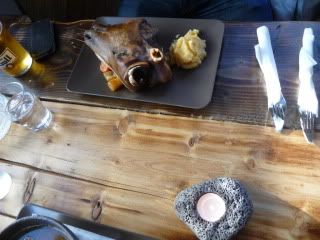
The famous sheep’s head. It tastes like regular sheep, nothing special about it. I ate the eye and it tasted like nothing – the only flavour was from the leftover meat I hadn’t managed to pick off, stuck around the edges of the eyeball. It was chewy. I don’t like sheep much in general (only hangikjöt, Icelandic-style smoked lamb) so I don’t like sheep’s head either.
You get half a head, and you’re supposed to cut into it and rip the jaw off to get access to more of the meat, if I remember right (which I probably don’t). If you go to a restaurant and order it the waitress will be able to show you how it’s done.
Now I will leave you with some normal, Icelandic-brand foods:

The fishballs are “Danish” but talking to a Faroe Islander who had lived in Denmark for some time, they hadn’t seen a kind like this where they look fried but you boil them to heat them up.

Build vocabulary, practice pronunciation, and more with Transparent Language Online. Available anytime, anywhere, on any device.
About the Author: sequoia
I try to write about two-thirds of the blog topics on cultural aspects and one-third on the language, because there's much more out there already on the language compared to daily life information. I try to stay away from touristy things because there's more of that out there than anything else on Iceland, and I feel like talking about that stuff gives you the wrong impression of Iceland.




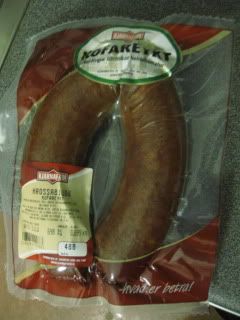




Comments:
Jols:
Hey,
I’ve been learning Icelandic for about a month… And your blog is precious help because I’m moving there in September! (so I better get going haha)
I was wondering – would you consider making a post about all the ways to say “horse” in Icelandic? Hestur, hross, …. I know there are many, many more, and I’m sure there are differences in meaning but I don’t really understand them.
In any case, thank you for your blog as it is!
Helen:
Thank you for this. It’s nice to see some every day items and what to expect if we visit Iceland.